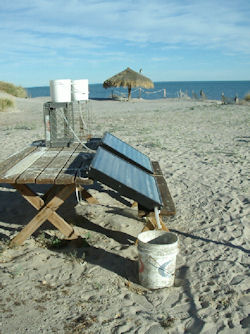 |  |
By Georgia Tanner

On the Gulf of California coast south of San Felipe, people use solar panels and backup generators for energy. Living is casual in these "campos turisticos," and there is a diversity of house sizes and styles. There are houses with solar systems big enough to run just about any appliance found in a luxury home on the electricity grid, but most places are "sustainable" in the sense that they satisfy essential human needs without requiring an excess of space, energy, and maintenance. There are tiny houses; two-story houses; trailers; rooms joined to trailers; ramadas with water tanks on top and parking for a motorhome or trailer underneath. Many places are upbeat and cheerful, with a style that’s impossible to pin down. Without a lot of building codes and inspectors, it’s possible to be creative and experiment with materials and design. Or let the design unfold. My solar house 30 miles south of San Felipe was built of recycled wood and windows; the previous owners started with a room next to a trailer, added another room, removed the trailer, added a sundeck, etc. Such shelters are a light-hearted balance to some of the resource-gobbling concrete mansions being built in other Baja locations. The idea of camp after all is playfulness, spontaneity, and freedom.

Weather on Baja’s northeast coast is also impossible to pin down. At any season the climate can seduce the visitor with incomparable calm and sparkling days and nights. Summer winds may spring up off the sea, bring moisture from the south, or swing west out of the parching desert. Winter winds may blow for days out of the north. William Butler Yeats wrote:
"Come let us mock at the great
That had such burdens on the mind
And toiled so hard and late
To leave some monument behind
Nor thought of the levelling wind."
Those lines from "Nineteen Hundred and Nineteen" always remind me of my former home. That “levelling wind” cleans the tracks off dunes and beaches, rips the paper off roofs, enters the cracks between walls and windows, keeps one inside reading Thoreau or making tortilla soup. No studies have been made, but it’s my guess that beer consumption goes up on north-wind days almost as much as on it does on days when the mercury rises.
Living out of ice chests for a year made me realize that refrigeration is more than a luxury; in an isolated place with scorching summers, refrigerators are an item of worship. Many residents south of San Felipe have propane refrigerators to save on the cost of their solar systems. Others have refrigerators that run on either propane or solar, and some have refrigerator/freezers that run exclusively on solar power, such as the much-admired Sunfrost. In summer, heaven is having ice.

A solar system that is independent, that is, not tied into the electric grid, usually consists of panels, batteries, inverter(s), and another way to charge the batteries--a gasoline or propane generator, and possibly a wind charger. The latter are not often seen in the area because they do make some noise and they have certain requirements: a sustained wind speed of 25 to 30 mph and a tower mount 15 feet higher than any surrounding objects within a 500-foot radius. Thus solar cells do most of the charging on the northern Gulf, where sunlight is strong and plentiful. If a homeowner doesn’t want to cut back on the use of electrical appliances, a generator can provide power when cloudy days hide the sun. A generator may also be handy for the higher currents required to run power tools or an air conditioner. As a courtesy to neighbors, and to themselves, users try to run their generators only when necessary. The peace and silence of the northern Gulf is one of its blessings.
Solar panels require little maintenance except cleaning dust off the glass; an efficiency option is tilting the panels up in the fall for a better angle during winter months and lowering them in the spring for the high summer sun. Lead-acid batteries, the most common type in the area, need to be kept clean and ventilated, and the electrolyte checked at least monthly and topped off with distilled water. Since I used solar stills to make drinking water from the sea, I had distilled water for batteries too.
The size of solar panels, the number of batteries, the model of inverter, and the resulting cost of the system can all be calculated based on the actual current draw of the desired appliances. The satisfactions of having your own power plant include freedom from utility companies, black-outs, and rate raises (solar panel costs are coming down steadily) and increased independence from the results of wild weather or human error.



Excelente servicio on there part every time

Quick and easy! Never a problem with Baja Bound Ins.

Excellent customer service